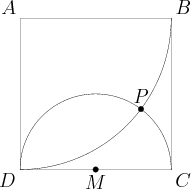Difference between revisions of "2003 AMC 12A Problems/Problem 17"
m |
(Added another solution.) |
||
| Line 50: | Line 50: | ||
Note that <math>P</math> is merely a reflection of <math>D</math> over <math>AM</math>. Call the intersection of <math>AM</math> and <math>DP</math> <math>X</math>. Drop perpendiculars from <math>X</math> and <math>P</math> to <math>AD</math>, and denote their respective points of intersection by <math>J</math> and <math>K</math>. We then have <math>\triangle DXJ\sim\triangle DPK</math>, with a scale factor of 2. Thus, we can find <math>XJ</math> and double it to get our answer. With some analytical geometry, we find that <math>XJ=\frac{8}{5}</math>, implying that <math>PK=\frac{16}{5}</math>. | Note that <math>P</math> is merely a reflection of <math>D</math> over <math>AM</math>. Call the intersection of <math>AM</math> and <math>DP</math> <math>X</math>. Drop perpendiculars from <math>X</math> and <math>P</math> to <math>AD</math>, and denote their respective points of intersection by <math>J</math> and <math>K</math>. We then have <math>\triangle DXJ\sim\triangle DPK</math>, with a scale factor of 2. Thus, we can find <math>XJ</math> and double it to get our answer. With some analytical geometry, we find that <math>XJ=\frac{8}{5}</math>, implying that <math>PK=\frac{16}{5}</math>. | ||
| + | |||
| + | ==Solution 3== | ||
| + | As in Solution 2, draw in <math>DP</math> and <math>AM</math> and denote their intersection point <math>X</math>. Next, drop a perpendicular from <math>P</math> to <math>AD</math> and denote the foot as <math>Z</math>. <math>AP \cong AD</math> as they are both radii and similarly <math>DM \cong MP</math> so <math>APMD</math> is a kite and <math>DX \perp XM</math> by a well-known theorem. | ||
| + | |||
| + | Pythagorean theorem gives us <math>AM=2 \sqrt{5}</math>. Clearly <math>\triangle XMD \sim \triangle XDA \sim \triangle DMA \sim \triangle ZDP</math> by angle-angle and <math>\triangle XMD \cong \triangle XMP</math> by Hypotenuse Leg. | ||
| + | Manipulating similar triangles gives us <math>PZ=\frac{16}{5}</math> | ||
== See Also == | == See Also == | ||
Revision as of 22:50, 6 December 2012
Contents
[hide]Problem
Square ![]() has sides of length
has sides of length ![]() , and
, and ![]() is the midpoint of
is the midpoint of ![]() . A circle with radius
. A circle with radius ![]() and center
and center ![]() intersects a circle with radius
intersects a circle with radius ![]() and center
and center ![]() at points
at points ![]() and
and ![]() . What is the distance from
. What is the distance from ![]() to
to ![]() ?
?
![]()
Solution 1
Let ![]() be the origin.
be the origin. ![]() is the point
is the point ![]() and
and ![]() is the point
is the point ![]() . We are given the radius of the quarter circle and semicircle as
. We are given the radius of the quarter circle and semicircle as ![]() and
and ![]() , respectively, so their equations, respectively, are:
, respectively, so their equations, respectively, are:
![]()
![]()
Algebraically manipulating the second equation gives:
![]()
![]()
![]()
![]()
Substituting this back into the first equation:
![]()
![]()
![]()
![]()
![]()
![]()
![]()
![]()
Solving each factor for 0 yields ![]() . The first value of
. The first value of ![]() is obviously referring to the x-coordinate of the point where the circles intersect at the origin,
is obviously referring to the x-coordinate of the point where the circles intersect at the origin, ![]() , so the second value must be referring to the x coordinate of
, so the second value must be referring to the x coordinate of ![]() . Since
. Since ![]() is the y-axis, the distance to it from
is the y-axis, the distance to it from ![]() is the same as the x-value of the coordinate of
is the same as the x-value of the coordinate of ![]() , so the distance from
, so the distance from ![]() to
to ![]() is
is ![]()
Solution 2
Note that ![]() is merely a reflection of
is merely a reflection of ![]() over
over ![]() . Call the intersection of
. Call the intersection of ![]() and
and ![]()
![]() . Drop perpendiculars from
. Drop perpendiculars from ![]() and
and ![]() to
to ![]() , and denote their respective points of intersection by
, and denote their respective points of intersection by ![]() and
and ![]() . We then have
. We then have ![]() , with a scale factor of 2. Thus, we can find
, with a scale factor of 2. Thus, we can find ![]() and double it to get our answer. With some analytical geometry, we find that
and double it to get our answer. With some analytical geometry, we find that ![]() , implying that
, implying that ![]() .
.
Solution 3
As in Solution 2, draw in ![]() and
and ![]() and denote their intersection point
and denote their intersection point ![]() . Next, drop a perpendicular from
. Next, drop a perpendicular from ![]() to
to ![]() and denote the foot as
and denote the foot as ![]() .
. ![]() as they are both radii and similarly
as they are both radii and similarly ![]() so
so ![]() is a kite and
is a kite and ![]() by a well-known theorem.
by a well-known theorem.
Pythagorean theorem gives us ![]() . Clearly
. Clearly ![]() by angle-angle and
by angle-angle and ![]() by Hypotenuse Leg.
Manipulating similar triangles gives us
by Hypotenuse Leg.
Manipulating similar triangles gives us ![]()










